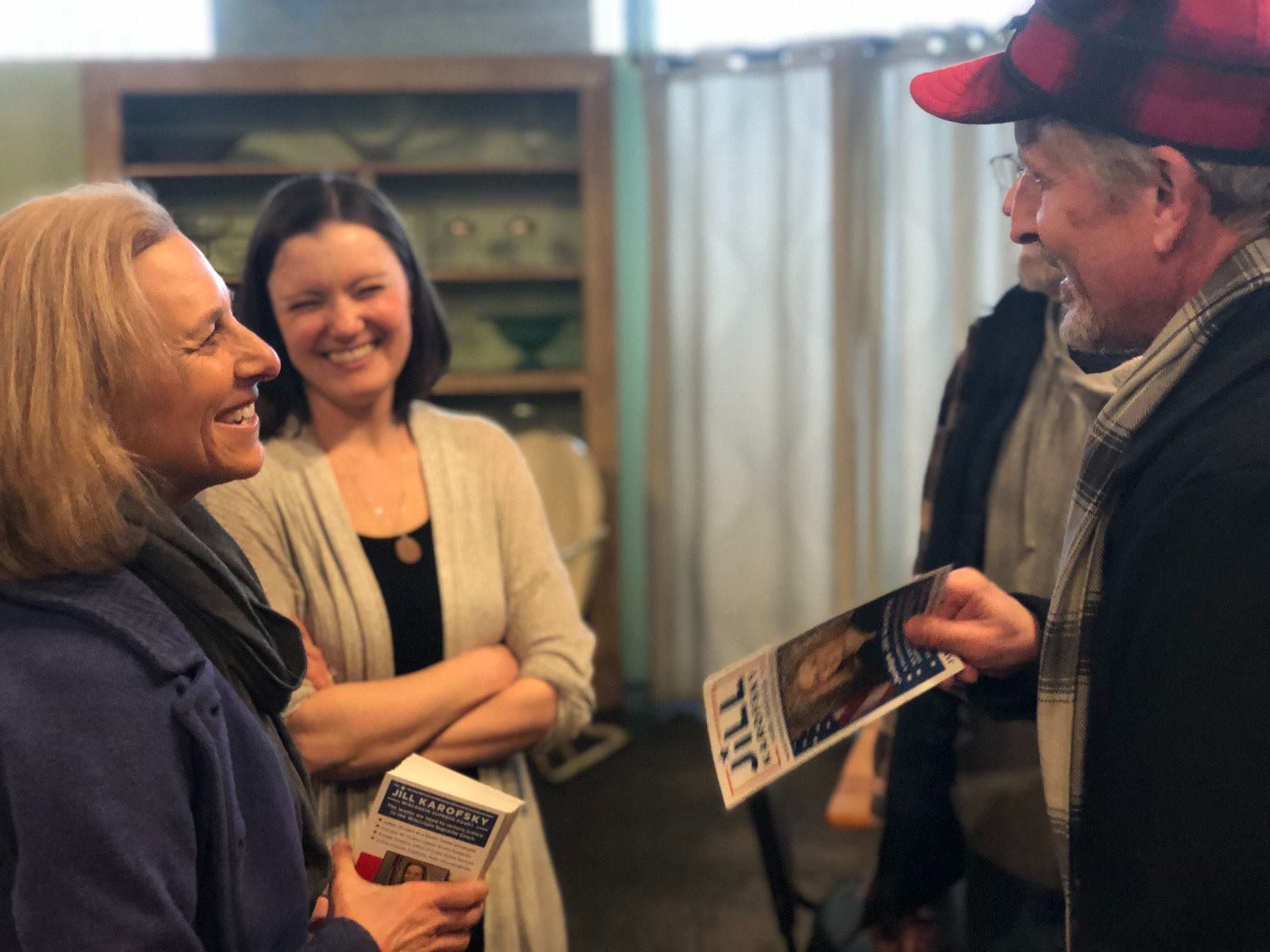Political Report
In Wisconsin, Liberal Challenger Wins Despite Voting Restrictions and Tough-on-Crime Playbook
Jill Karofsky ousted a conservative Supreme Court Justice in an election marred by the COVID-19 pandemic, poll closures, and missing absentee ballots.

Jill Karofsky ousted a conservative Supreme Court Justice in an election marred by the COVID-19 pandemic, poll closures, and missing absentee ballots.
Wisconsin Supreme Court Justice Daniel Kelly and his Republican backers executed the tough-on-crime playbook perfectly. They stoked fear about violent crime and lenient judges. They tarred his challenger, a judge who has talked openly about the need to reduce incarceration, as an “activist.” They racked up law enforcement endorsements. In the final stretch, they also exploited a global pandemic to restrict voter access, with help from conservative judges on both the state Supreme Court and the U.S. Supreme Court.
But in the end, that wasn’t enough. On Monday, trial court judge Jill Karofsky claimed victory over Kelly, a staunch conservative who was appointed to the court by former Republican Governor Scott Walker and endorsed, at a raucous Milwaukee rally, by President Trump. Karofsky enjoyed help from the Democratic Party, including endorsements by former Vice President Joe Biden and U.S. Senator Bernie Sanders.
The win gives Karofsky a ten-year term, and narrows the court’s conservative majority to a single vote, 4–3.
Liberals will have an opportunity to flip the majority in 2023, when Chief Justice Pat Roggensack is up for reelection. Conservatives have controlled the court, which is often at the center of Wisconsin’s most contentious policy disputes, since 2008.
Karofsky’s victory adds a voice in support of criminal justice reform to a court not known for protecting the rights of people involved in the criminal legal system. On the whole, its decisions favor the power of police and prosecutors over people accused or suspected of crimes, often unanimously.
During the campaign, Karofsky acknowledged the need for criminal justice reform in Wisconsin, and said that judges have some role in enacting it, in part by offering their perspective from the bench to lawmakers. “As someone who’s been on the frontlines of the judicial system for the last 30 years, let me tell you—if you’ve been in that system for five seconds you can see that it’s in need of reform,” she said during one debate. “The Department of Corrections budget in Wisconsin is more than the Department of Education budget,” she said at another event. “How does that make sense?”
She said that Wisconsin should reform its cash bail system to protect low-income people. She also proposed that judges lead efforts to create specialized courts that provide pathways to mental health and addiction treatment over incarceration. Karofsky’s proposal invokes the same administrative rulemaking authority that in 2017 the Wisconsin Supreme Court used to launch a special court to hear major commercial disputes. (Critics said that the court, ostensibly designed to resolve commercial cases more efficiently, unfairly favors big business.)
Kelly’s campaign and his supporters, meanwhile, fearmongered about crime, a well-worn template in judicial elections, with attacks on Karofsky’s record as a prosecutor and trial judge. Kelly’s campaign said that Karofsky let “hardened criminals off easy.” One ad from the Republican State Leadership Committee claimed that, as a prosecutor, Karofsky “went easy on criminal predators”—a claim supported by reference to a single case that Karofsky had nothing to do with, according to the fact-checking website PolitFact. It was the same Willie-Horton style politics that for decades fueled mass incarceration in America, and that helped build the Wisconsin court’s conservative supermajority that Kelly was running to preserve.
There were a number of other issues at stake, including voting rights, education policy, and the rights of consumers and workers. Indeed, some of the soft-on-crime attack ads were paid for by the state’s largest business group, Wisconsin Manufacturers & Commerce, which doesn’t even list criminal justice as one of its nine issue areas. The court is a key arbiter of power in the state, which explains why its elections have become so expensive, and why, in this case, there was a chaotic partisan fight over whether, and how, to hold the election amid a pandemic.
The election was expected to be competitive—the previous race for a seat on the court was decided by fewer than 6,000 votes—and Republicans feared that holding the election on the same day as Wisconsin’s presidential primary, as had been done for decades, would hurt Kelly since only Democrats had a competitive primary. (In an effort to protect Kelly, Republican lawmakers in 2018 pushed a measure that would have split the two elections, moving the primary to March while leaving the supreme court and other state elections in April, but eventually backed down.)
But COVID-19 shuffled expectations. With public health orders to stay home, poll workers dropped out, and polling locations closed down. By election day, Milwaukee had reduced its polling locations from 180 to five, and Green Bay was down from 31 to two. At the same time, a surge in requests for absentee ballots created a backlog that election officials had no hope of clearing by election day. Tens of thousands of people did not receive their absentee ballots in time to return them—eligible voters, disenfranchised through no fault of their own.
The pandemic presented an opportunity for Republicans. With poll closures hitting Milwaukee hard and affecting Black voters, and more mail-in ballot requests in Republican-majority areas, letting the election proceed could result in massive voter suppression to their—and Kelly’s—advantage. Even as many other states postponed their primaries, Republican lawmakers refused to move the election or even order absentee ballots sent to every voter, as Democratic Governor Tony Evers requested. For his part, Evers failed to take unilateral action—and even announced at one point that he lacked the legal authority to do so—until the eleventh hour, when he issued an executive order postponing the election until June 9. Evers’s order followed a federal court ruling that gave voters an extra week to return absentee ballots.
Republicans challenged both Evers’s order and the federal ruling, underscoring a crucial though often overlooked aspect of voter suppression: Whatever the tactic to reduce turnout—closing polling places, voter ID laws, purging voter rolls, exploiting a pandemic—it only works if you have judges on your side. Judicial selection, whether through elections or appointments, is an essential cog in the voter suppression machine.
In this case, the machine worked as designed. First the Wisconsin Supreme Court struck down Evers’s executive order in a 4–2 decision (Kelly did not participate), and then, hours later, the U.S. Supreme Court issued an unsigned 5–4 opinion that erased the delay for submitting absentee ballots. Both decisions broke along usual ideological lines, with conservative justices in each majority. And both prompted stinging dissents that accused the majorities of ignoring how holding the election as planned, with many people forced to vote in-person if at all, would endanger entire communities and force people to choose between voting and their health.
Deepak Gupta, an attorney in Washington, D.C., and one of the Supreme Court’s most prominent practitioners, wrote on Twitter that, “as someone . . . who likes to believe that there is such a thing as ‘law’ that can be kept in a separate sphere from raw partisan politics, a moment like this makes me almost physically sick.”
The partisan maneuvering in this case fits a pattern of Wisconsin Republicans manipulating election rules to their advantage. As the New York Times reported, “Tuesday’s mess of an election in Wisconsin [was] the culmination of a decade of efforts by state Republicans to make voting harder, redraw legislative boundaries and dilute the power of voters in the state’s urban centers,” through tactics such as partisan gerrymandering and a discriminatory voter ID law.
Karofsky’s win does not dispel concerns about courts’ indifference toward ensuring high and healthy democratic participation. The rulings did not dictate the outcome, but they still matter. Many people were disenfranchised. Others waited in long lines, placing their health at grave risk. Poll workers had to wear protective gear. Turnout decreased by more in Milwaukee County compared to the 2016 and 2018 general elections than it did in Milwaukee’s conservative suburbs.
And the courts’ failure to protect democracy even in this dire scenario is a distressing harbinger in the run up to November’s general elections.
This year was already expected to set a new record for election-related litigation, law professor Rick Hasen wrote on Election Blog. Now, Hasen wrote, “with election changes proliferating and a fight over expanded absentee balloting necessary to combat the COVID crisis, the amount of litigation is going to skyrocket.”
That ultimately puts voting rights in the hands of the courts, including the federal appellate courts that Donald Trump has reshaped at record pace. In just one term he has appointed more than a quarter of all federal appellate court judges, filling the judiciary with ideological conservatives picked because they’ll side with Republicans on a number of issues, including voting rights. Just as Trump opposes vote-by-mail because it “doesn’t work out well for Republicans,” he is appointing federal judges who are ready to strike down expanded access to the ballot.
If Wisconsin’s elections signaled the importance of judicial selection, there is much more to come. The Wisconsin Supreme Court could soon rule on a conservative interest group’s lawsuit to purge more than 200,000 people from the voter rolls.
“There is a lot of work to do now to try to avoid election meltdown,” Hasen wrote.
